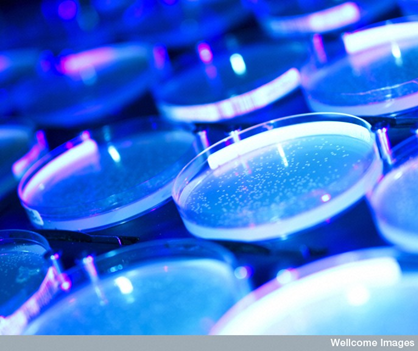Drinking Water Microbiology: Complex Ecosystems and Emerging Threats

The following blog was submitted by Emily Garner, a PhD student in CEE, as part of the requirements for GRAD 5414 Water for Health Seminar Interdisciplinary Seminar. This course examines emerging interdisciplinary issues related to the chemistry, microbiology, engineering and health aspects of drinking water.
As you are likely aware, we are surrounded by millions of microorganisms in our environment every day. Even the human body is comprised of 100 trillion bacteria, known as the human microbiome, that often perform beneficial actions such as helping to digest food, producing essential vitamins, and providing a level of protection against potentially harmful microbes [1]. Scientists are continually striving to learn more about the microbes that colonize humans and provide these beneficial roles, as well as the bacteria that can cause harm.
Much like the human microbiome, the drinking water microbiome has been a topic of interest for research in recent years. It is a common misconception that our drinking water is sterile. Though treatment plants provide disinfection to help eliminate bacteria, regrowth of microorganisms can occur in the distribution system. By the time water reaches the tap, it is actually home to a diverse community of microorganisms with as many as 100 million cells per liter [2]. The pipes that supply water to your home, the distribution system, may more accurately be viewed as a complex ecosystem where microorganisms, both harmless bacteria and pathogens, can actively grow and prosper, rather than a sterile environment. Similar to the human microbiome, many of these drinking water microbes could potentially be beneficial by providing a level of protection against colonization of distribution system pipes by pathogens.
This week’s Water for Health class welcomed Dr. Husen Zhang from Civil and Environmental Engineering to lead a discussion on the changing face of our understanding of drinking water microbiology. Regulatory monitoring of microbial water quality is generally limited to screening for microorganisms that act as indicators of likely fecal contamination, such as total coliforms, but improvements in molecular tools and sequencing capabilities have allowed researchers to gain a much deeper understanding of what microbes can be found in our drinking water. For example, one of the papers discussed in class demonstrated that a distribution system can be home to a diverse community of microbes that may be significantly altered when operating conditions, such as the type of disinfectant residual, change in the system [3]. The researchers found bacteria belonging to 9 different phyla and as many as 256 different distinct bacterial species (known as OTUs) in any given drinking water sample. While traditional microbiological monitoring of drinking water relies on culture-based methods, only approximately 1% of drinking water bacteria can be grown in the lab, which is largely due to the difficulty associated with reproducing the nutrient-limited growth conditions under which drinking water bacteria grow. Additionally, some bacteria may be living, or viable, but in a state that simply cannot be cultured, a state referred to as viable but nonculturable [4]. High throughput sequencing and molecular techniques similar to those employed in the aforementioned study have been central to the development of knowledge regarding microorganisms in drinking water, as they overcome the limitations associated with culture-based methods by directly targeting microbial DNA.
Advancements in understanding of microbiology in drinking water over the last decades have also led to the recognition of a new class of drinking water microbial constituents, known as emerging pathogens, which are important to human health [4]. These include fecal pathogens that were previously not suspect for drinking water transmission (for example, enteric viruses and Heliobacter pylori), pathogens that are well suited for growth in the distribution system (such as Legionella pneumophila and Pseudemonas aeruginosa), and toxins from cyanobacteria. Recognition of these potential threats has created an opportunity for scientists and engineers to study how to improve our water safety and quality to avoid potential outbreaks associated with these emerging pathogens.
References:
[1] Kolata, G. (2012, June 13). In Good Health? Thank Your 100 Trillion Bacteria. Retrieved February 21, 2015, from http://www.nytimes.com/2012/06/14/health/human-microbiome-project-decodes-our-100-trillion-good-bacteria.html?pagewanted=all&_r=0
[2] Pinto, A. (2014, December 7). Managing microbial migrations in drinking water systems. Retrieved February 24, 2015, from http://microbe.net/tag/drinking-water/
[3] Hwang, C., Ling, F., Andersen, G., LeChevallier, M., & Liu, W. (2012). Microbial Community Dynamics of an Urban Drinking Water Distribution System Subjected to Phases of Chloramination and Chlorination Treatments. Applied Environmental Microbiology, 78(22), 7856-7865.
[4] Szewzyk, U., Szewzyk, R., Manz, W., & Schleifer, K. (2000). Microbiological Safety of Drinking Water. Ann. Rev. Microbiol., 54, 81-127.


